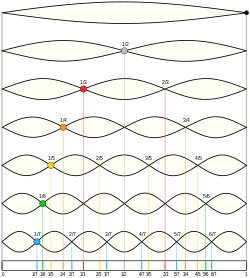| Bridge position | Colour codes | Attack tone : open string [4] | Resonating fundamental of the counterpart: [4] open string | Corresponding overtone related : open string | Corresponding overtone : fundamental of the counterpart | Cents of string parts [5] Body : Neck |
|---|
| 0 | | Unison | Unison | | | |
| 1/16 | Grey line | 4 octaves | Just minor second (16:15) | 4 octaves | Just major seventh (15:8) 22ma | 111.73 : 4800.00 |
| 1/12 | Green line | Just perfect fifth (3:2) 22ma | Lesser undecimal neutral second (12:11) | Just perfect fifth (3:2) 22ma | Lesser undecimal tritone (11:8) 22ma | 150.64 : 4302.00 |
| 1/11 | Yellow line | Lesser undecimal tritone (11:8) 22ma | Greater undecimal neutral second (11:10) | Lesser undecimal tritone (11:8) 22ma | Just major third (5:4) 22ma | 165.00 : 4151.30 |
| 1/10 | Orange line | Just major third (5:4) 22ma | Lesser just major second (10:9) | Just major third (5:4) 22ma | Greater just major second (9:8) 22ma | 182.40 : 3986.30 |
| 1/9 | Red line | Greater just major second (9:8) 22ma | Greater just major second (9:8) | Greater just major second (9:8) 22ma | 3 octaves | 203.91 : 3803.90 |
| 1/8 | Grey line | 3 octaves | Septimal major second (8:7) | 3 octaves | Harmonic seventh (7:4) 15ma | 231.17 : 3600.00 |
| 1/7 | Blue dot | Harmonic seventh (7:4) 15ma | Septimal minor third (7:6) | Harmonic seventh (7:4) 15ma | Just perfect fifth (3:2) 15ma | 266.87 : 3368.80 |
| 1/6 | Green dot | Just perfect fifth (3:2) 15ma | Just minor third (6:5) | Just perfect fifth (3:2) 15ma | Just major third (5:4) 15ma | 315.64 : 3102.00 |
| 1/5 | Yellow dot | Just major third (5:4) 15ma | Just major third (5:4) | Just major third (5:4) 15ma | 2 octaves | 386.31 : 2786.30 |
| 1/4 | Orange dot | 2 octaves | Just perfect fourth (4:3) | 2 octaves | Just perfect fifth (3:2) 8va | 498.04 : 2400.00 |
| 2/7 | Blue dot | Harmonic seventh (7:4) 8va | Lesser septimal tritone (7:5) | Harmonic seventh (7:4) 15ma | Just major third (5:4) 15ma | 582.51 : 1782.51 |
| 1/3 | Red dot | Just perfect fifth (3:2) 8va | Just perfect fifth (3:2) | Just perfect fifth (3:2) 15ma | Octave | 701.96 : 1901.96 |
| 2/5 | Yellow dot | Just major third (5:4) 8va | Just major sixth (5:3) | Just major third (5:4) 15ma | Just perfect fifth (3:2) 8va | 884.36 : 1586.31 |
| 3/7 | Blue dot | Septimal minor third (7:6) 8va | Harmonic seventh (7:4) | Harmonic seventh (7:4) 15ma | 2 octaves | 968.83 : 1466.87 |
| 1/2 | Grey dot | Octave | Octave | Octave | Unison | 1200.00 : 1200.00 |
| 4/7 | Blue dot | Harmonic seventh (7:4) | Septimal minor third (7:6) 8va | Harmonic seventh (7:4) 15ma | Just perfect fifth (3:2) 8va | 1466.87 : 968.83 |
| 3/5 | Yellow dot | Just major sixth (5:3) | Just major third (5:4) 8va | Just major third (5:4) 15ma | Octave | 1586.31 : 884.36 |
| 2/3 | Red dot | Just perfect fifth (3:2) | Just perfect fifth (3:2) 8va | Just perfect fifth (3:2) 8va | Unison | 1901.96 : 701.96 |
| 5/7 | Blue dot | Lesser septimal tritone (7:5) | Harmonic seventh (7:4) 8va | Harmonic seventh (7:4) 15ma | Octave | 1782.51 : 582.51 |
| 3/4 | Orange dot | Just perfect fourth (4:3) | 2 octaves | 2 octaves | Unison | 2400.00 : 498.04 |
| 4/5 | Yellow dot | Just major third (5:4) | Just major third (5:4) 15ma | Just major third (5:4) 15ma | Unison | 2786.30 : 386.31 |
| 5/6 | Green dot | Just minor third (6:5) | Just perfect fifth (3:2) 15ma | Just perfect fifth (3:2) 15ma | Unison | 3102.00 : 315.64 |
| 6/7 | Blue dot | Septimal minor third (7:6) | Harmonic seventh (7:4) 15ma | Harmonic seventh (7:4) 15ma | Unison | 3368.80 : 266.87 |





